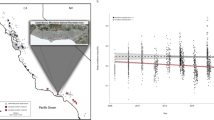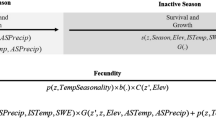Abstract
There is general consensus that climate change has contributed to the observed decline, and extinction, of many amphibian species throughout the world. However, the mechanisms of its effects remain unclear. A laboratory study in 1980–1981 in which temperate zone amphibians that were prevented from hibernating had decreased growth rates, matured at a smaller size and had increased mortality compared with those that hibernated suggested one possible mechanism. I used data from a field study of common toads (Bufo bufo) in the UK, between 1983 and 2005, to determine whether this also occurs in the field. The results demonstrated two pathways by which global warming may cause amphibian declines. First, there was a clear relationship between a decline in the body condition of female common toads and the occurrence of warmer than average years since 1983. This was paralleled by a decline in their annual survival rates with the relationship between these two declines being highly correlated. Second, there was a significant relationship between the occurrence of mild winters and a reduction in female body size, resulting in fewer eggs being laid annually. Climate warming can, therefore, act on wild temperate zone amphibians by deleteriously affecting their physiology, during and after hibernation, causing increased female mortality rates and decreased fecundity in survivors.






Similar content being viewed by others
References
Alexander MA, Eischeid JK (2001) Climate variability in regions of amphibian declines. Conserv Biol 15:930–942
Beebee TJC (1995) Amphibian breeding and climate. Nature 374:219–220
Beebee TJC, Griffiths RA (2005) The amphibian decline crisis: a watershed for conservation biology? Biol Conserv 125:271–285
Berger L, Speare R, Daszak P, Green DE, Cunningham AA, Slocombe R, Goggin CL, Hyatt AD, MacDonald KR, Hines HB, Lips KR, Marantelli G, Parkes HH (1998) Chytridiomycosis causes amphibian mortality associated with population declines in the rainforests of Australia and Central America. Proc Natl Acad Sci USA 95:9031–9036
Biek R, Funk WC, Maxell BA, Mills LS (2002) What is missing in amphibian decline research: insights from ecological sensitivity analysis. Conserv Biol 16:728–734
Blaustein R, Wake DB (1990) Declining amphibian populations: a global phenomenon? Trends Ecol Evol 5:203–204
Blaustein AR, Wake DB (1995) The puzzle of declining amphibian populations. Sci Am 272:56–61
Blaustein AR, Wake DB, Sousa WP (1994) Amphibian declines: judging stability, persistence, and susceptibility of populations to local and global extinctions. Conserv Biol 8:60–71
Blaustein AR, Romansic JM, Kiesecker JM (2003) Ultraviolet radiation, toxic chemicals and amphibian population declines. Divers Distrib 9:123–140
Carey C, Alexander MA (2003) Climate change and amphibian declines: is there a link? Divers Distrib 9:111–121
Choquet R, Reboulet AM, Lebreton JD, Gimenez O, Pradel R (2005) U-CARE 2.2 user’s manual. CEFE, Montpellier, France (http://www.ftp.cefe.cnrs.fr/biom/Soft-CR/)
Collins JP, Storfer A (2003) Global amphibian declines: sorting the hypotheses. Divers Distrib 9:89–98
Davidson C (2004) Declining downwind: amphibian population declines in California and historical pesticide use. Ecol Appl 14:1892–1902
Easterling DR, Horton B, Jones PD, Peterson TC, Karl TR, Parker DE, Salinger MJ, Razuvayev V, Plummer N, Jamason P, Folland CK (1997) Maximum and minimum temperature trends for the globe. Science 277:364–367
Garner TWJ, Walker S, Bosch J, Hyatt AD, Cunningham AA, Fisher MC (2005) Chytrid fungus in Europe. Emerg Infect Dis 11:1639–1640
Hels T, Nachman G (2002) Simulating viability of a spadefoot toad Pelobates fuscus metapopulation in a landscape fragmented by a road. Ecography 25:730–744
Houlahan JE, Findley CS, Schmidt BR, Meyer AH, Kuzmin SL (2000) Quantitative evidence for global amphibian population declines. Nature 404:752–755
Jones PD, Mann ME (2004) Climate over past millennia. Rev Geophys 42:1–42
Jørgensen CB (1986) External and internal control of patterns of feeding, growth and gonadal function in a temperate zone anuran, the toad Bufo bufo. J Zool 210:211–241
Kiesecker JM, Blaustein AR, Belden LK (2001) Complex causes of amphibian declines. Nature 410:681–683
King D (2005) Climate change: the science and the policy. J Appl Ecol 42:779–783
La Marca E, Lips KR, Lötters S, Puschendorf R, Ibáñez R, Rueda-Almonacid JV, Schulte R, Marty C, Castro F, Manzanilla-Puppo J, García-Pérez JE, Bolaños F, Chaves G, Pounds JA, Toral E, Young BE (2005) Catastrophic population declines and extinctions in neotropical Harlequin frogs (Bufonidae: Atelopus). Biotropica 37:190–201
Laurance WF (1996) Catastrophic declines of Australian rainforest frogs: is unusual weather responsible? Biol Conserv 77:203–212
Lebreton JD, Burnham KP, Clobert J, Anderson DR (1992) Modelling survival and testing hypotheses using marked animals: a unified approach with case studies. Ecol Monogr 62:67–118
Lips KR (1998) Decline of a tropical montane amphibian fauna. Conserv Biol 12:106–117
Lips KR, Green DE, Papendick R (2003) Chytridiomycosis in wild frogs from southern Costa Rica. J Herpetol 37:215–218
Lips KR, Burrowes PA, Mendelson JR, Parra-Olea G (2005) Amphibian population declines in Latin America: A synthesis. Biotropica 37:222–226
Pounds JA (2001) Climate and amphibian declines. Nature 410:639–640
Pounds JA, Crump ML (1994) Amphibian declines and climate disturbance: the case of the golden toad and the harlequin frog. Conserv Biol 8:72–85
Pounds JA, Bustamante MR, Coloma LA, Consuegra JA, Fogden MPL, Foster PN, La Marca E, Masters KL, Merino-Viteri A, Puschendorf R, Ron SR, Sánches-Azofeifa GA, Still CJ, Young BE (2006) Widespread amphibian extinctions from epidemic disease driven by global warming. Nature 439:161–167
Pradel R, Wintrebert CMA, Gimenez O (2003) A proposal for a goodness-of-fit test to the Arnason-Schwarz multisite capture-recapture model. Biometrics 59:43–53
Puschendorf R (2003) Atelopus varius (harlequin frog). Fungal infection. Herpetol Rev 34:355
Reading CJ (1986) Egg production in the common toad, Bufo bufo. J Zool 208:99–107
Reading CJ (1998) The effect of winter temperatures on the timing of breeding activity in the common toad Bufo bufo. Oecologia 117:469–475
Reading CJ, Clarke RT (1995) The effects of density, rainfall and environmental temperature on body condition and fecundity in the common toad, Bufo bufo. Oecologia 102:453–459
Reading CJ, Clarke RT (1999) Impacts of climate and density on the duration of the tadpole stage of the common toad Bufo bufo. Oecologia 121:310–315
Scherer RD, Muths E, Noon BR, Corn PS (2005) An evaluation of weather and disease as causes of decline in two populations of boreal toads. Ecol Appl 15:2150–2160
Schmidt BR, Schaub M, Anholt BR (2002) Why you should use capture-recapture methods when estimating survival and breeding probabilities: on bias, temporary emigration, over dispersion, and common toads. Amphib Reptil 23:375–388
Stuart SN, Chanson JS, Cox NA, Young BE, Rodrigues ASL, Fischman DL, Waller RW (2004) Status and trends of amphibian declines and extinctions worldwide. Science 306:1783–1786
Vonesh JR, De la Cruz O (2002) Complex life cycles and density dependence: assessing the contribution of egg mortality to amphibian declines. Oecologia 133:325–333
White GC, Burnham KP (1999) Program MARK: survival estimation from populations of marked animals. Bird Study 46:120–138
Acknowledgments
I wish to thank an anonymous referee for detailed and constructive suggestions regarding the CMR analysis using MARK, and P. Rothery for assistance with the statistical analysis. I also wish to thank K. Moore who recorded the daily meteorological data for the Swanage area and the staff of the Swanage Tourist Information Centre for allowing me access to the weather data. The permanent marking of toads was licensed under the UK Animals (Scientific Procedures) Act 1986.
Author information
Authors and Affiliations
Corresponding author
Additional information
Communicated by Anssi Laurila.
Rights and permissions
About this article
Cite this article
Reading, C.J. Linking global warming to amphibian declines through its effects on female body condition and survivorship. Oecologia 151, 125–131 (2007). https://doi.org/10.1007/s00442-006-0558-1
Received:
Accepted:
Published:
Issue Date:
DOI: https://doi.org/10.1007/s00442-006-0558-1




